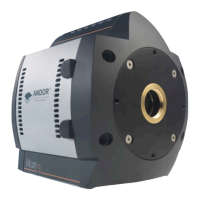Page 74
Appendix
A1.1.17 - Shot Noise
Shot Noise is due to basic physical laws and cannot be removed. Any signal, whether it is a dark signal or a light signal,
will have shot noise associated with it. Most simply dened:
Ifthesignalordarksignal=N electrons, the shot noise is the square root of N.
You can do nothing about the shot noise of your signal, but by choosing minimum exposures and operating the CCD at
suitably low temperatures, the dark signal, and hence the noise from the dark signal, can be reduced.
A1.1.18 - Signal To Noise Ratio
The Signal to Noise Ratio (commonly abbreviated as S/N or SNR) is the ratio between a given signal and the noise
associated with that signal. Noise has a xed component, and a variable component (shot noise) which
isthesquarerootofthesignal.Thus,theS/Nusuallyincreases(improves)asthesignalincreases.
ThemaximumS/Nistheratiobetweenthemaximumsignal(i.e.thesaturationlevel)andthenoiseassociatedwiththat
signal. At near saturation levels the dominant source of noise is the shot noise of the signal.

